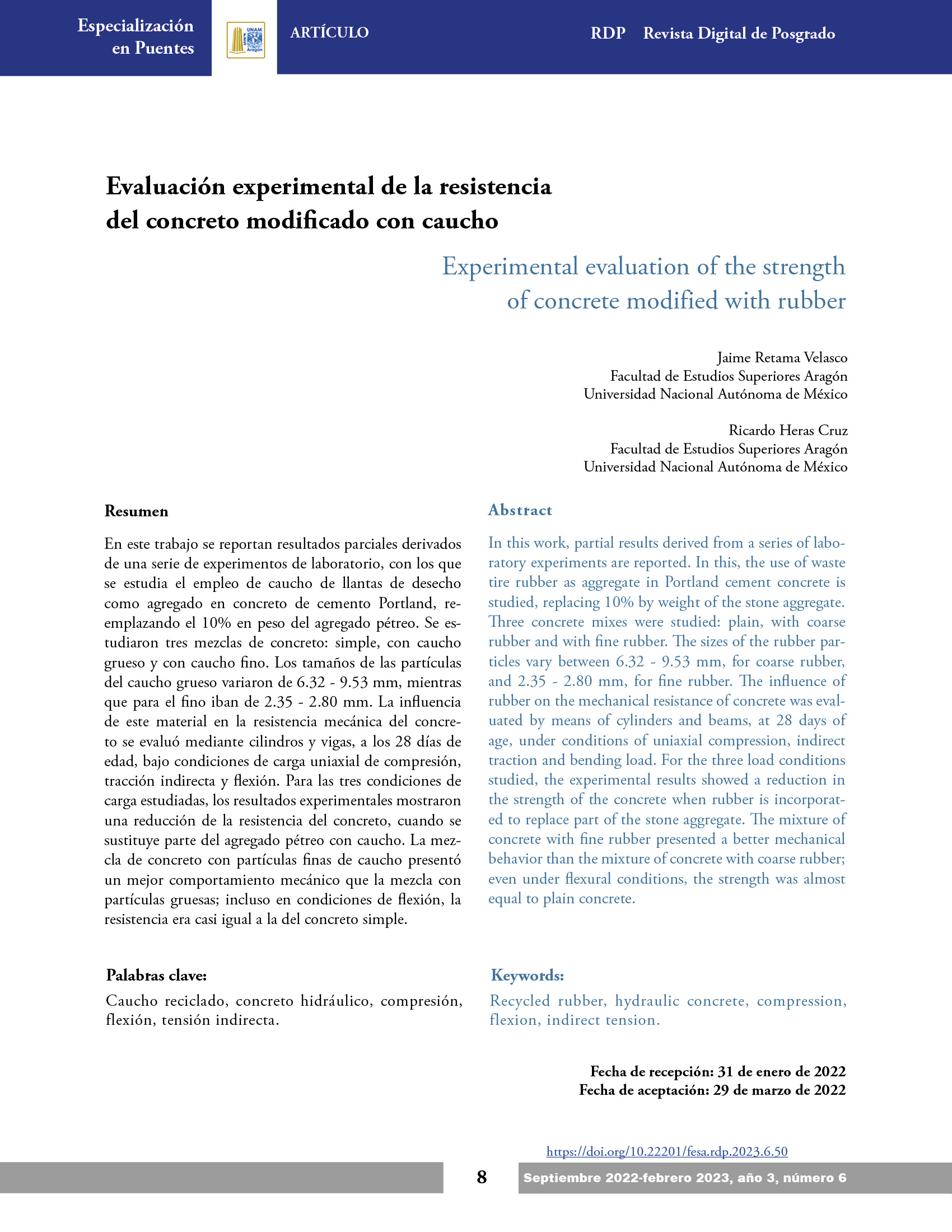Experimental Eevaluation of the Strength of Concrete Modified with Rubber
DOI:
https://doi.org/10.22201/fesa.rdp.2023.6.50Keywords:
Recycled rubber, hydraulic concrete, compression, flexion, indirect tension.Abstract
In this work, partial results derived from a series of laboratory experiments are reported. In this, the use of waste tire rubber as aggregate in Portland cement concrete is studied, replacing 10% by weight of the stone aggregate. Three concrete mixes were studied: plain, with coarse rubber and with fine rubber. The sizes of the rubber particles vary between 6.32 - 9.53 mm, for coarse rubber, and 2.35 - 2.80 mm, for fine rubber. The influence of rubber on the mechanical resistance of concrete was evaluated by means of cylinders and beams, at 28 days of age, under conditions of uniaxial compression, indirect traction and bending load. For the three load conditions studied, the experimental results showed a reduction in the strength of the concrete when rubber is incorporated to replace part of the stone aggregate. The mixture of concrete with fine rubber presented a better mechanical
behavior than the mixture of concrete with coarse rubber; even under flexural conditions, the strength was almost equal to plain concrete.
References
American Concrete Institute. (2009). Standard Practice for Selecting Proportions for Normal, Heavyweight, and Mass Concrete (ACI 211.1-91).
American Society for Testing and Materials. (2010). ASTM C293/C293M-10. Standard Test Method for Flexural Strength of Concrete (Using Simple Beam with Center-Point Loading).
American Society for Testing and Materials. (2011). ASTM C496/C496M-11. Standard Test Method for Splitting Tensile Strength of Cylindrical Concrete Specimens.
American Society for Testing and Materials. (2015a). ASTM C192/C192M-15. Standard Practice for Making and Curing Concrete Test Specimens in the Laboratory.
American Society for Testing and Materials. (2015b). ASTM C39/C39M-15a. Standard Test Method for Compressive Strength of Cylindrical Concrete Specimens.
Arioglu, N., Girgin, Z. C., & Arioglu, E. (2006). The Evaluation of Ratio Between Splitting Tensile Strength and Compressive Strength for Concretes Up to 120 Mpa and Its Applications in Strength Criterion. ACI Materials Journal, 103 (1), 18-24. https://www.concrete.org/publications/internationalconcreteabstractsportal.aspx?m=details&ID=15123
Batayneh, M. K., Marie, I., & Asi, I. (2008). Promoting the Use of Crumb-Rubber Concrete in Developing Countries. Waste Management, 28, 2171-2176. DOI: 10.1016/j.wasman.2007.09.035
DeGroot, D. H. (2007). Mexico-US Cross-Border Resolution of Waste Tire Disposal. Proceedings of the 2007 Worlds Environmental and Water Resources Congress. DOI: 10.1061/40927(243)301
Eldin, N. N., & Senouci, A. B. (1992). Use of Scraps Tires in Road Construction. Journal of Construction Engineering and Management, 118(3), 561-576. DOI: 10.1061/(ASCE)0733-9364(1992)118:3(561)
Eldin, N. N., & Piekarski, J. (1993). Scrap Tires: Management and Economics. Journal of Environmental Engineering, 119, 1217-1232. DOI: 10.1061/(ASCE)0733-9372(1993)119:6(1217)
Gere, J. M. & Timoshenko, S. P. (1991). Chapter 5. Stresses in Beams. In Mechanics of materials. Springer-Science Business Media.
Ghaly, A. N., & Cahill, IV J. D. (2005). Correlation of Strength, Rubber Content, and water to cement ratio in rubberized concrete. Canadian Journal of Civil Engineering, 32(6), 1075-1081. https://doi.org/10.1139/l05-063
Girskas, G., & Nagrockiene, D. (2017). Crushed Rubber Waste Impact of Concrete Basic Properties. Construction and Building Materials, 140, 36-42. https://doi.org/10.1016/j.conbuildmat.2017.02.107
Huang, B., Li, G., Pang, J., & Eggers, J. (2004). Investigation into Waste Tire Rubber Filled Concrete. Journal of Materials in Civil Engineering, 16 (3), 187-194. DOI: 10.1061/(ASCE)0899-1561(2004)16:3(187)
Humphrey, D., & Blumenthal, M. (2010). The Use of Tire-Derived Aggregated in Road Construction Applications, Green Streets and Highways Conference 2010. ASCE 2011, 299-313. DOI: 10.1061/41148(389)25.
Khatib, Z.K., & Bayomy, F. M. (1999). Rubberized Portland Cement Concrete. Journal of Materials in Civil Engineering, 11(3), 206-213. DOI: 10.1061/(ASCE)0899-1561(1999)11:3(206)
Li, G., Stubblefield, M. A., Garrick, G., Eggers, J., Abadie, C., & Huang, B. (2004), Development of Waste Tire Modified Concrete. Cement and Concrete Research, 34(12), 2283-2289. DOI: 10.1016/j.cemconres.2004.04.013
Llantrac México. (2022, 24 de junio). Reciclaje de llantas en México, ¿cómo vamos? https://llantrac.com.mx/blog/reciclaje-de-llantas-en-mexico-como-vamos#:~:text=Se%20estima%20que%20en%20M%C3%A9xico,de%20unidades%20podr%C3%ADan%20ser%20reutilizadas.
Ma, F., Dai, J., Fu, Z., Liu, J., Dong, W., & Huang, Z. (2020, October). A New Type of Crumb Rubber Asphalt Mixture: A Dry Process Design and Performance Evaluation. Applied Sciences, 10, 372. DOI: 10.3390/app10010372
Oden, J. T., & Ripperger, E. A. (1981). Chapter 4. Stresses and Stress Resultants in Bars. In Mechanics of elastic structures. McGraw-Hill.
Presti, D. L. (2013). Recycled Tyre Rubber Modified Bitumens for Road Asphalt Mixtures: A Literature Review. Construction and Building Materials, 49, 863-881. DOI: 10.1016/j.conbuildmat.2013.09.007
Retama, J., & Ayala, A. G. (2017). Influence of Crumb-Rubber in the Mechanical Response of Modified Portland Cement Concrete. Advances in Civil Engineering, 2017, 1-9. DOI: 10.1155/2017/3040818
Sadowski, T., & Pietras, D. (2014). Description of Degradation Process of Rubberized Lean Concrete. Solid State Phenomena, 216, 67-72. DOI: 10.4028/www.scientific.net/SSP.216.67
Shu, X., & Huang, B. (2014). Recycling of Waste Tire Rubber in Asphalt and Portland Cement Concrete: An Overview. Construction and Building Materials, 67B, 217-224. https://doi.org/10.1016/j.conbuildmat.2013.11.027
Tajik, N. (2011). Chapter 2. Factors Influencing on the Early Age Thermal Cracking. In Early Age Thermal Cracking in Concrete Structures. Lab Lambert Academic Publishing.
Topcu, I. (1995). The Properties of Rubberized Concretes. Cement and Concrete Research, 25(2), 304-310. DOI: 10.1016/0008-8846(95)00014-3
Xue, G., & Pei, Z. (2018). Experimental Study on Axial Compressive Properties of Rubber Concrete at Low Temperature. Journal of Materials in Civil Engineering, 30(3), 1-8. DOI: 10.1061/(ASCE)MT.1943-5533.0002178
Youssf, O., Mills, J. E., & Hassanli, R. (2016). Assessment of the Mechanical Performance of Crumb Rubber Concrete. Construction and Building Materials, 125, 175-183. DOI: 10.1016/j.conbuildmat.2016.08.040
Zhang, Y., Liu, Z., & Peng, J. (2019). Silane Modification of Crumb Rubber on The Rheological Properties of Rubberized Asphalt. Applied Sciences, 9, 1-11. DOI: 10.3390/app9224831

Downloads
Published
How to Cite
Issue
Section
License
Copyright (c) 2022 Universidad Nacional Autónoma de México

This work is licensed under a Creative Commons Attribution-NonCommercial-NoDerivatives 4.0 International License.




